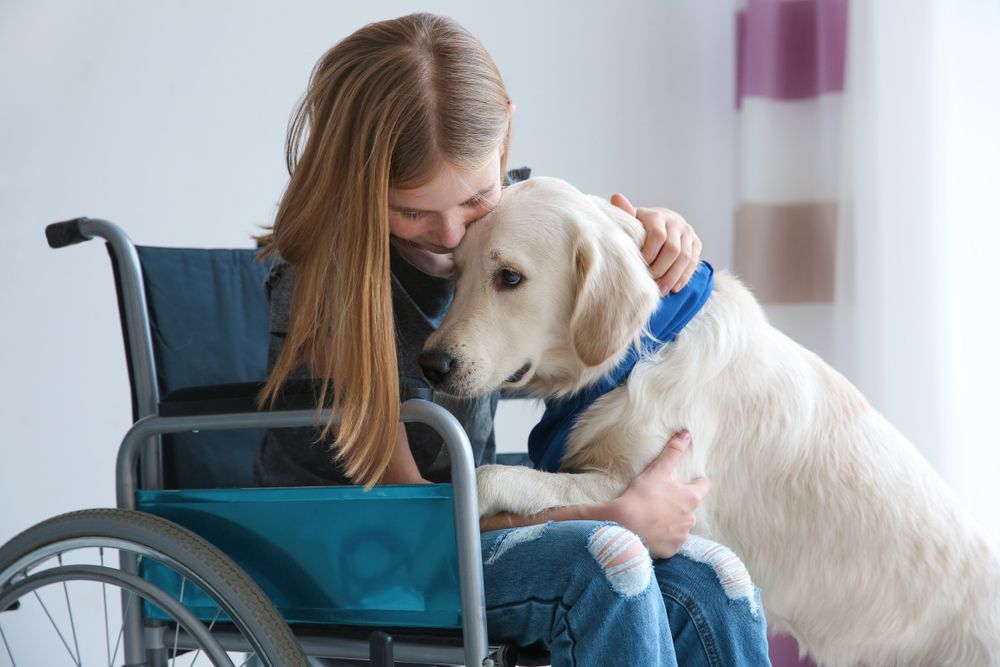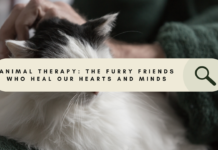Last Updated on May 9, 2024 by Dogs Vets
Animal Therapy: The Furry Friends Who Heal Our Hearts and Minds
Have you ever felt an inexplicable sense of calm wash over you as you pet a purring cat or watched a playful dog frolic in the park? It’s not just your imagination.
Animals have a unique ability to connect with us on a deep level, offering companionship, comfort, and even therapeutic benefits.
This powerful connection is the cornerstone of animal therapy, a rapidly growing field that harnesses the human-animal bond to improve our physical, mental, and emotional well-being.
In this comprehensive guide, we’ll delve into the fascinating world of animal therapy, exploring:
- The science behind the wagging tail: We’ll unveil the biological and psychological mechanisms that explain how interacting with animals can positively impact our health.
- Who can benefit from animal therapy: We’ll explore the diverse range of conditions that animal therapy can address, from anxiety and depression to physical rehabilitation and chronic illnesses.
- The different types of animal therapy: We’ll unpack the various modalities of animal therapy, including animal-assisted therapy (AAT), animal-assisted activities (AAA), and service animals.
- The furry (and feathery) therapists: We’ll introduce you to the most common animals used in animal therapy programs, exploring their unique strengths and suitability for different needs.
- Finding the right program for you: We’ll provide practical guidance on how to locate reputable animal therapy programs and ensure a safe and positive experience.
- The ethical considerations: We’ll address the importance of animal welfare in animal therapy and discuss responsible practices for ensuring the well-being of our furry friends.
So, whether you’re a pet owner curious about the science behind your purring companion’s calming effect or someone seeking alternative approaches to managing a health condition, this guide is for you.
Buckle up, and get ready to embark on a heartwarming journey into the world of animal therapy!
The Science Behind the Wagging Tail: Why Animals Make Us Feel Better
The human-animal bond is a complex tapestry woven from millennia of co-evolution. Studies suggest that interacting with animals triggers the release of oxytocin, a neurohormone associated with feelings of love, trust, and bonding.
This “cuddle chemical” promotes relaxation, reduces stress hormones like cortisol, and lowers blood pressure, leading to a calmer and more positive emotional state.
Beyond the hormonal symphony, simply stroking an animal’s soft fur can provide a sense of comfort and security.
The unconditional love and acceptance radiating from our furry companions can be a powerful antidote to loneliness and isolation.
Additionally, caring for an animal can foster a sense of purpose and responsibility, boosting self-esteem and motivation.

Who Can Benefit from Animal Therapy? A Spectrum of Support
The therapeutic benefits of animal therapy extend far beyond simple stress relief.
Research has shown its effectiveness in addressing a wide range of physical, mental, and emotional challenges, including:
- Mental health conditions: Animal therapy has been shown to be beneficial for individuals struggling with anxiety, depression, post-traumatic stress disorder (PTSD), and phobias.
- Cognitive decline: Studies suggest that interacting with animals can stimulate cognitive function and improve memory in individuals with dementia or Alzheimer’s disease.
- Physical rehabilitation: Animal therapy can be used to motivate patients undergoing physical therapy, improve motor skills, and manage chronic pain.
- Developmental disabilities: Children with autism spectrum disorder (ASD) often show significant improvements in social interaction and communication skills after participating in animal therapy programs.
- Childhood trauma: The presence of a therapy animal can provide a sense of safety and security for children who have experienced trauma, facilitating emotional expression and coping mechanisms.
The Different Types of Animal Therapy: Tailoring Support to Specific Needs
The term “animal therapy” encompasses a spectrum of interventions, each with a distinct focus and approach.
Let’s explore the three most common types:
-
Animal-Assisted Therapy (AAT): This is a formal therapeutic intervention delivered by a mental health professional with a specially trained animal. AAT sessions have clear goals and are integrated into a patient’s overall treatment plan.
-
Animal-Assisted Activities (AAA): This is a more informal approach often used in non-clinical settings like nursing homes or schools. AAA programs aim to improve overall well-being and social interaction through animal interactions, but they are not considered a form of therapy.
-
Service Animals: Trained service animals, such as guide dogs for the visually impaired or hearing assistance dogs, are not considered part of animal therapy. However, they play a vital role in supporting individuals with disabilities and improving their independence.
The Furry (and Feathery) Therapists: A Menagerie of Animal Helpers
The world of animal therapy boasts a diverse cast of characters, each with unique strengths and suitability for different needs.
Here are some of the most common animal ambassadors in the realm of emotional and physical well-being:
-
Dogs: Man’s (and woman’s) best friend takes the top spot for a reason. Dogs are incredibly social creatures, adept at reading human emotions and offering unconditional love and support. Their playful nature can encourage physical activity and social interaction, making them ideal companions for individuals struggling with isolation or physical limitations.
-
Cats: These enigmatic felines might seem aloof, but their gentle purrs and calming presence have a demonstrably therapeutic effect. Studies have shown that stroking a cat can lower blood pressure and reduce stress. For people who find comfort in quiet companionship, cats can be wonderful therapy partners.
-
Horses: Equine therapy, which involves interacting with horses on the ground or horseback riding, has proven effective in improving motor skills, balance, and coordination. Additionally, caring for these majestic animals can foster a sense of responsibility and build self-confidence.
-
Dolphins: Dolphin-assisted therapy (DAT) has gained traction in recent years, showing promise in alleviating symptoms of autism spectrum disorder (ASD) and other developmental disabilities. The playful nature of dolphins and the unique aquatic environment can create a stimulating and calming experience for participants.
-
Rabbits and small animals: For individuals who may be intimidated by larger animals, smaller creatures like rabbits, guinea pigs, and even birds can provide a gentle form of animal therapy. These animals are often used in AAA programs in senior care facilities, offering companionship and fostering a sense of calm.
It’s important to remember that not all animals are suited for therapy work. Temperament, training, and experience are crucial factors.
Therapy animals undergo rigorous screening and training to ensure they are comfortable in various environments and can interact safely with people of all ages and abilities.
Finding the Right Program for You: Unlocking the Power of the Human-Animal Bond
If you’re interested in exploring animal therapy, the first step is to consult with your doctor or therapist.
They can help you determine if animal therapy is a suitable complement to your existing treatment plan.
Once you have the green light, here are some tips for finding the right program:
- Ask for recommendations: Talk to your doctor, therapist, or local animal shelter for recommendations on reputable animal therapy programs in your area.
- Research the program: Look for programs that are certified by a reputable organization, such as the Pet Partners Therapy Education Program (PPTEP) or the Delta Society.
- Observe an interaction: If possible, observe a therapy session to get a sense of the program’s environment and the animal’s temperament.
- Consider your needs: Think about your specific goals and any anxieties you might have about interacting with animals. Communicate these openly with the program provider.
Remember, animal therapy is a collaborative effort. The therapist, the animal handler, and you all play a crucial role in ensuring a safe and positive experience.
Ethical Considerations: Putting Our Furry Friends First
As with any therapy involving animals, ethical considerations are paramount.
Here are some key points to remember:
- Animal welfare is a top priority: Therapy animals should be well-cared for, trained humanely, and have breaks during sessions.
- Animal suitability: Not all animals are suited for therapy work. Their temperament, training, and overall well-being must be carefully considered.
- Informed consent: Individuals participating in animal therapy should be fully informed about the program and comfortable interacting with the animals.
By prioritizing animal welfare and responsible practices, we can ensure that animal therapy continues to be a force for good in the world.

The Therapeutic Touch: Activities and Benefits of Animal Therapy
Now that you’ve met the furry and feathery therapists and understand how to find a reputable program, let’s delve into the practical aspects of animal therapy sessions.
These sessions can incorporate a variety of activities, tailored to the specific needs of the participant and the animal’s strengths.
Here are some examples:
-
Brushing and petting: The simple act of stroking an animal’s fur can be incredibly calming and promote relaxation. This is particularly helpful for individuals struggling with anxiety or stress.
-
Feeding and caring for the animal: Taking responsibility for an animal’s well-being, even in a small way, can foster a sense of purpose and boost self-esteem. This can be beneficial for children or individuals with developmental disabilities.
-
Walking or playing with the animal: Engaging in activities like walking a dog or playing fetch can encourage physical activity and improve motor skills. This is a great option for individuals undergoing physical rehabilitation or managing chronic pain.
-
Non-verbal communication: For individuals with communication difficulties, such as those on the autism spectrum, interacting with animals can provide a safe space for non-verbal communication and emotional expression.
-
Sensory stimulation: Animals can provide a variety of sensory experiences – the soft fur of a cat, the rhythmic walking of a horse, or the playful squawks of a parrot. These experiences can be stimulating and calming for individuals with sensory processing difficulties.
The benefits of participating in animal therapy programs are vast and can be experienced on multiple levels:
- Emotional well-being: Animal therapy can reduce anxiety, depression, and loneliness, while promoting feelings of relaxation, calmness, and social connection.
- Physical health: Interacting with animals can encourage physical activity, improve motor skills, and manage chronic pain.
- Cognitive function: Animal therapy has shown promise in improving memory and cognitive function in individuals with dementia or Alzheimer’s disease.
- Social interaction: For individuals who struggle with social interaction, animal therapy can provide a safe space to connect and build relationships.
Beyond the Session: The Lasting Impact of Animal Therapy
The positive effects of animal therapy often extend far beyond the therapy session itself.
The human-animal bond can provide a sense of comfort and security that can last a lifetime.
Here are some ways animal therapy can create a lasting impact:
- Improved coping mechanisms: The skills learned during animal therapy sessions, such as relaxation techniques or social interaction strategies, can be applied to everyday life.
- Increased motivation and self-esteem: Taking care of an animal and witnessing the positive responses it evokes can boost self-esteem and motivation.
- A sense of purpose: For individuals who may feel isolated or lack a sense of purpose, caring for an animal can provide a valuable sense of responsibility and routine.
Animal therapy is a powerful tool that can complement traditional treatment plans and enhance overall well-being.
If you’re looking for a natural and holistic approach to managing a health condition or simply seeking a furry friend to brighten your day, animal therapy might be the perfect path for you.
Frequently Asked Questions (FAQs) about Animal Therapy
Are there any risks associated with animal therapy?
While generally safe, there are some potential risks associated with animal therapy, such as allergies or minor scratches. It’s important to disclose any allergies you may have before participating in a program. Reputable programs will take steps to minimize risks by ensuring the animals are well-cared for and properly trained.
How much does animal therapy cost?
The cost of animal therapy can vary depending on the program, location, and frequency of sessions. Some programs may offer sliding scale fees or accept donations.
Can I participate in animal therapy if I’m afraid of animals?
If you have a mild fear of animals, a qualified therapist can help you gradually overcome your apprehension in a safe and controlled environment. However, if you have a severe phobia, animal therapy might not be the right fit.
What if I don’t own a pet? Can I still benefit from animal therapy?
Absolutely! Many animal therapy programs utilize trained therapy animals specifically for therapeutic purposes. You don’t need to own a pet to experience the benefits of animal interaction.
How do I know if animal therapy is right for me?
The best way to determine if animal therapy is right for you is to consult with your doctor or therapist. They can help you assess your needs and determine if animal therapy could be a beneficial addition to your treatment plan.

Conclusion
The human-animal bond is a powerful force that has the potential to heal our hearts, minds, and bodies.
Animal therapy harnesses this connection to provide a unique and effective form of therapy. By incorporating furry (and feathery) friends into our well-being journeys, we can unlock a world of emotional, physical, and social benefits.
So, if you’re looking for a complementary approach to managing a health condition, fostering social connection, or simply seeking a furry confidante, consider opening your heart and mind to the transformative power of animal therapy.
Verified Sources:
- American Psychological Association: https://www.apa.org/
- Pet Partners Therapy Education Program: https://petpartners.org/
- Delta Society: https://philanthropynewsdigest.org/features/nonprofit-spotlight/delta-society
- National Institute of Mental Health: https://www.nimh.nih.gov/
- Mayo Clinic: https://newsnetwork.mayoclinic.org/discussion/home-remedies-animals-as-healers-2/
















